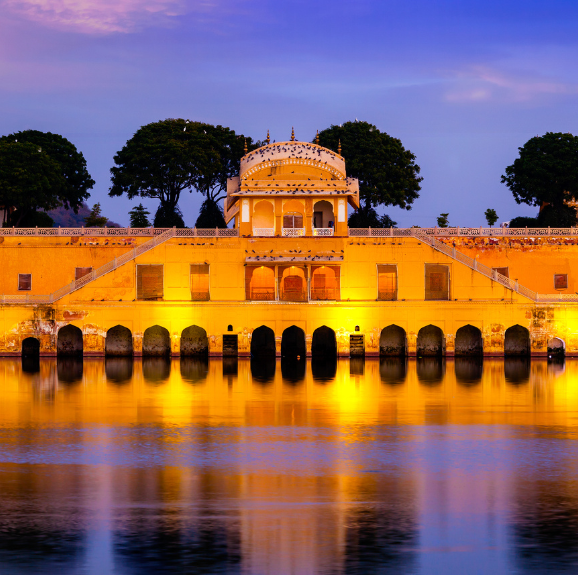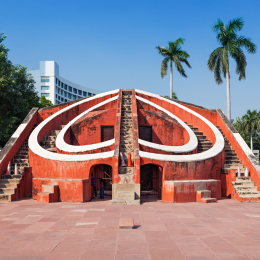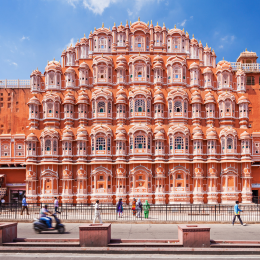Jaipur, the capital of Rajasthan, is a vibrant city where the past and present coalesce into a remarkable tapestry of history, culture, and architectural beauty. Known as the Pink City for the terracotta pink hue that covers much of the city, Jaipur is
a city steeped in regal charm, with its grand palaces, forts, and bustling markets that echo centuries of royal heritage. The city was founded in 1727 by Maharaja Sawai Jai Singh II, who, with his keen sense
of astronomy and planning, transformed Jaipur into a well-organized, strategically-designed metropolis that continues to captivate visitors today.
Jaipur: The Pink City – A Glorious Blend of History, Culture, and Architecture
Rajathan, India



Overview
Historical Significance
Jaipur’s history is inextricably linked with the Rajput rulers and the Mughal influences that shaped its identity. The city was designed by Vidyadhar Bhattacharya, a Bengali architect, who meticulously followed the principles of Vastu Shastra (ancient
Indian science of architecture) and Shilpa Shastra, creating a city that is not only aesthetically appealing but also a marvel of urban planning. The architecture of Jaipur blends traditional Rajput and
Mughal styles, with the use of red sandstone and marble, resulting in structures that are both grand and inviting.
In 1876, the city’s buildings were painted a distinct pink to honor the visit of the Prince of Wales, a tradition that continues today, giving Jaipur its famous moniker, The Pink City. The charm of the pink color and the planned urban design of the city
create an almost magical atmosphere that draws thousands of tourists each year.
Key Attractions
Amber Fort (Amer Fort)
Hawa Mahal (Palace of Winds)
City Palace
Jantar Mantar
Jaipur's Gateways and Walled City
Jaipur is a treasure trove of culture, arts, and crafts. The city has long been known as a hub for traditional Rajasthani crafts, including gemstones, textiles, and handicrafts. Jaipur’s bazaars, especially the Johari Bazaar (for jewelry) and Bapu Bazaar
(for textiles), are brimming with stalls selling precious stones, gold and silver jewelry, embroidered textiles, and block-printed fabrics.
Jaipur Rugs and Textiles
- Jaipur is famous for its handwoven textiles, especially block-printed fabrics, and Jaipur rugs. The intricate designs and vibrant colors of these textiles make them highly prized. Many shops and local markets feature beautiful sarees, dupattas, and scarves crafted with traditional techniques passed down through generations.
Gemstones and Jewellry
- The city is renowned for its gemstones, especially emeralds, sapphires, and diamonds. Johari Bazaar in particular is a paradise for those interested in fine jewelry, where you can find jewelry studded with the famous Meenakari (enamel) work, kundan, and polki diamonds.
Fairs and Festivals
- Jaipur hosts a variety of cultural events and festivals throughout the year. The Jaipur Literature Festival attracts authors, scholars, and literary enthusiasts from around the world. The Teej Festival, which celebrates the arrival of monsoon, and Diwali, the Festival of Lights, are celebrated with much fanfare, with beautifully decorated markets, vibrant processions, and cultural performances.
Traditional Dance and Music
- Jaipur is home to many forms of traditional dance and music, with Kathak (a classical dance form) and Ghoomar (a traditional Rajasthani dance) being especially popular. The city also boasts a rich tradition of folk music, with performances often heard during festivals and local celebrations.
Jaipur is not just a visual feast but also a treat for the taste buds. The city’s Awadhi and Rajasthani cuisine is flavorful and aromatic, with many dishes influenced by the royal Nawabi court.
Dal Baati Churma
- A quintessential Rajasthani dish, Dal Baati Churma consists of baked wheat dough balls served with spicy dal (lentils) and a sweet, crumbled dessert made from the same dough. This dish encapsulates the hearty flavors of the region.
Ghewar
- Ghewar, a traditional Rajasthani sweet, is especially popular during the Teej festival. It is made from flour, ghee, and sugar syrup, and often garnished with pistachios and silver foil.
Pyaaz Kachori
- A popular street food, Pyaaz Kachori is a deep-fried pastry filled with spicy onion filling, typically served with tamarind chutney.
Laal Maas
- Laal Maas is a fiery, spicy mutton curry that embodies the bold, robust flavors of Rajasthani cuisine. It’s a must-try for those who love adventurous food.
Conclusion
Jaipur is a city of contrasts – where royal history mingles effortlessly with contemporary living. Its stunning architecture, vibrant culture, and culinary delights make it a city that invites exploration at every corner. Whether wandering through the
opulent Amber Fort, shopping for traditional textiles and gemstones, or enjoying the hustle and bustle of its colorful bazaars, Jaipur offers an unforgettable journey through Rajasthan’s royal past and lively
present.

